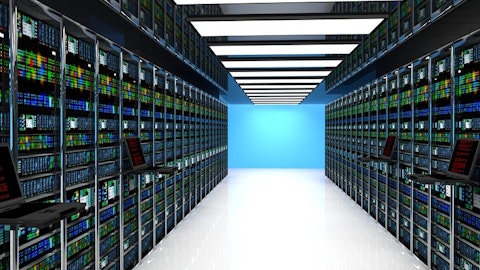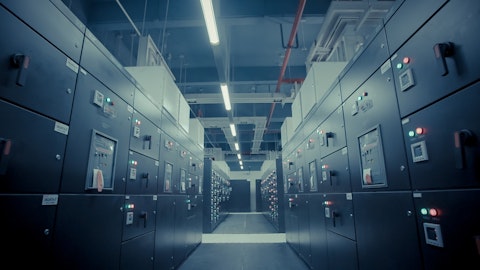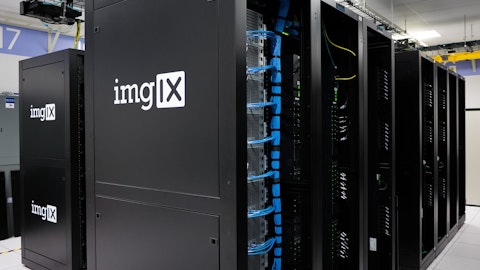Western Digital Corporation (NASDAQ:WDC) Q1 2024 Earnings Call Transcript October 30, 2023
Western Digital Corporation beats earnings expectations. Reported EPS is $-1.76, expectations were $-1.88.
Operator: Good morning, ladies and gentlemen and welcome to the Western Digital First Quarter Fiscal 2024 Earnings Call. All participants will be in a listen-only mode. [Operator Instructions] After today’s presentation there will be an opportunity to ask questions. [Operator Instructions] Please also note today’s event is being recorded. At this time I’d like to turn the floor over to Peter Andrew, VP of FP&A and Investor Relations. Sir, please go ahead.
Peter Andrew: Thank you, and good afternoon, everyone. Joining me today are David Goeckeler, Chief Executive Officer; and Wissam Jabre, Chief Financial Officer. Before I begin, we have a lot of exciting items to discuss today. In addition to the earnings press release and slides, we also have a press release and slides regarding the conclusion of our strategic review. All of these materials will be posted in the investor relations section of our website shortly. Let me remind everyone that today’s discussion contains forward-looking statements based on management’s current assumptions and expectations and as such does include risks and uncertainties. These forward-looking statements include expectations for our product portfolio, spending and cost reductions, business plans and performance, market trends, financial results, the outcome of a potential separation of our HDD and flash businesses, including the form, timing, and tax-free status of the transaction, our ability to complete the transaction, the future performance of our separated businesses, and the creation of shareholder value by separating our businesses.

An illustration of digital intelligence and energy storage for a modern industrial facility with servers and storage racks in the background.
We assume no obligation to update these statements. Please refer to our most recent financial report on Form 10-K and other filings with the SEC for more information on the risks and uncertainties that could cause actual results to differ materially. We will also make references to non-GAAP financial measures today. Reconciliation between the non-GAAP and comparable GAAP financial measures are included in the press release and other materials that are being posted in the investor relations section of our website. With that, I will now turn the call over to David for introductory remarks.
David Goeckeler: Thank you, Peter. Good morning and thank you for joining our call. I will first discuss the completion of the strategic review and then turn to our first quarter results. We’re thrilled to announce the completion of our strategic review and plans to form two independent public companies focused on capitalizing on the data storage industry’s growth in HDD and flash. After evaluating a comprehensive range of alternatives, the Western Digital management team and Board determined that spinning off its flash business is the best executable alternative at this time to fully realize value for shareholders. This transaction will allow each franchise to execute on its product and innovation roadmap and capitalize on the unique growth opportunities in their respective end markets.
Each company will benefit from streamlined management focus, operational flexibility, and the ability to set its own distinct capital allocation and shareholder return policies. We are excited for the opportunities this transaction creates to better serve our customers, support our suppliers, partners, and employees, and unlock significant value for our shareholders. Before discussing the details, let me walk you through the journey that brought us to this point. In March 2020, I joined Western Digital with a strong conviction in the company’s unique position to accelerate and benefit from the digital transformation that is reshaping every industry, every company, and how all of us live our daily lives. And importantly, I saw an opportunity to create value for a leader in both NAND flash and hard drives.
During my early days at the company, I spent considerable energy into rebuilding and refocusing the company, including the formation of the HDD and flash business units. It soon became clear that our focus on driving two distinct technology portfolios was the right strategy, and the new management team that I brought and worked together to transform Western Digital by bolstering business agility and reinvigorating innovation. In addition, we promptly focused on strengthening our balance sheet. We made the tough decision to suspend our dividend, which allowed Western Digital to speed up debt reduction and paid down $2.7 billion of debt over a couple of years following the suspension. We further enhanced our liquidity by bringing in $900 million of strategic investment from Apollo Global Management and Elliott Investment Management and amended our credit agreements.
We also settled a long-standing tax dispute to increase strategic optionality. The groundwork we laid over the past several years, including the additional actions taken in fiscal year ‘23 to right-size the business, have enabled us to navigate a dynamic environment, all while staying focused on delivering a range of industry-leading products. Each business is now in a strong operational position to succeed on its own and the actions we are announcing today will further enable each company to drive long-term success in the years to come. The Western Digital team and Board completed the strategic review after evaluating a comprehensive range of alternatives and determined that spinning off its flash business is the best executable alternative at this time to fully realize value for shareholders.
During our strategic review process, we evaluated material opportunities for each of our businesses. However, given current constraints, it has become clearer to the board in recent weeks that delivering a standalone separation is the right next step in the evolution of Western Digital and puts the company in the best position to unlock value for our shareholders, while providing strategic optionality for both businesses. Given the confidential nature of the strategic review, we will not be discussing any of the other alternatives that were considered during the process. On page six of the presentation, we present a separation transaction summary. The HDD business will retain the Western Digital name and become an independent publicly traded company.
The flash business is expected to be spun-off in a tax-free transaction to Western Digital shareholders, and the name of the publicly traded company will be determined at a later time. We target to complete these plans in the second-half of calendar year ‘24, subject to the principal closing conditions described in the slide. Page seven provides a bit more visibility into some of the end market exposure for our flash and HDD businesses on a trailing 12-month basis. Moving to the individual businesses on page eight. In HDD, Western Digital is a well-known leader in the mass storage market with an ability to generate consistent cash flow on a standalone basis. Our ability to lead the industry in bringing new innovations to the hard drive market to enable higher capacity points for mass market adoption has established Western Digital as a key strategic supplier to the world’s global cloud service providers, storage OEM, and distributors.
The massive opportunity is driven by the ongoing expansion of the cloud infrastructure, connected to intelligent endpoints and powered by high-speed networks. Industry analysts estimate the HDD addressable market to grow at approximately 12% compounded annual growth rate to $25 billion over the next three years with cloud representing over 90% of the total addressable market. The cloud represents an incredibly large and growing end market for Western Digital and we are well positioned to address customer storage needs. Moving to our flash business on page 10. The Western Digital flash business is well-known for its broad go-to-market channels, enviable premium brand retail franchise, and strong client SSD portfolio. Industry analysts forecast the flash market to grow at approximately 15% compounded annual growth rate over the next three years to $89 billion in calendar year 2025.
We believe content increases in the consumer and client end markets, as well as explosive growth of data created in the cloud by emerging applications such as generative AI, virtual reality, and autonomous driving, are driving a faster growth in flash versus HDD. The highlight of our consumer end market is the strength of our SanDisk brand of retail products and our suite of high-performance SSDs for gaming enthusiasts. The brand recognition and affinity, combined with our unmatched presence across the world, is a great setup for the business on a standalone basis. Our successful 23-year partnership with Kioxia continues to provide us a reliable source of high-performance, low-cost flash. Together, we have successfully brought to market numerous generations of flash technology with the industry’s lowest cost and best capital efficiency.
The joint venture fabs produce over 30% of the world’s bits and our joint memory technology roadmap remains incredibly well positioned especially as we lead the industry’s transition to wafer bonding. We will likely host an investor day closer to the time of the spin-off of our flash business to give investors greater clarity into the historical and future outlook for each of our businesses, along with the intended capital structures for each business. With that, I’d like to turn to first quarter fiscal ‘24 earnings review and business update. Western Digital’s first quarter results exceeded our expectations as the team’s efforts to bolster a business agility, drive innovation, and right-size the business have enabled us to capitalize on enhanced earning power in an improving environment.
We reported first quarter revenue of $2.75 billion and a non-GAAP loss per share of $1.76. Our ability to develop differentiated and innovative products across a broad range of end markets has resulted in sequential margin improvement across both flash and HDD businesses. In flash, healthy inventory levels on our balance sheet and signs that flash pricing is beginning to inflect have laid the groundwork for further gross margin improvements. Our broad go-to-market channels, enviable retail franchise, and strong client SSD portfolio have enabled us to shift bits to the most attractive end market categories and achieve 26% sequential bit growth, as well as upside and gross margin. In HDD, our industry leading 26 terabyte ultra-SMR drive became the highest near-line volume runner in just two quarters, which demonstrates Western Digital’s aerial density leadership and ability to deliver high volume innovative technologies to data center customers worldwide.
During the quarter, demand in consumer and client continued to improve, exceeding our expectations. In consumer, flash revenue has returned to growth on a year-over-year basis, led by strong content increases and unit growth. In client, PC and component demand also exceeded our expectations, and demand for gaming consoles and mobile remained resilient. In cloud, demand for both hard drive and flash products remains subdued. I’ll now turn to the business updates starting with flash. During the quarter, flash revenue increased sequentially, led by record exabyte shipments and continued content growth in consumer and client end markets, including PCs and all retail products, as we continue to optimize bit placement in an improving environment.
WD Black, which is optimized for gaming, continued to perform well, with bits shipments more than doubling and content per unit increasing over 50% year-over-year. We are in an excellent position from both of flash technology and capital efficiency perspective. Today, a majority of products we are shipping are based on BiCS5, the most capital efficient node in the 3D era that continues to provide an amazing cost structure and efficient capital spending. As we look into calendar year ‘24, we are ramping an array of QLC-based client SSDs based on BiCS6 technology to lead the expected industry transition to QLC. After BiCS6, we remain on track to introduce a broad range of high performance products based on BiCS8 technology with its unique chip bonded on array architecture.
Turning to HDD, revenue declined due to lower nearline exabyte shipments driven by subdued demand from our cloud customers and slower-than-expected recovery in China. However, demand for consumer and client hard drives was stable. Western Digital has continued to lead the industry in driving innovation within the nearline market. Our ability to bring innovation into mass market drives that are quickly deployed into cloud data centers is reflected in our results as we successfully led the industry’s transition to SMR-based nearline drives. Specifically, our 26 terabyte ultra-SMR drive, which we first announced at our investor day, accounted for nearly half of our nearline exabyte shipments with total SMR shipments exceeding the 40% goal we laid out in the same quarter a year prior.
We are on track with our 28 terabyte ultra-SMR drive qualification and have a clear roadmap of EPMR and ultra-SMR based innovations into the 40 terabyte range. These developments are a result of the choices we have made in the past few years through a combination of product R&D and manufacturing capabilities, and we are proud of how we have been executing against our strategy. Looking ahead to the fiscal second quarter, in flash we expect both modest bit and ASP improvement and a decline in underutilization charges to drive continued sequential improvement in both revenue and gross margin. In HDD, we expect higher nearline shipments and seasonal demand in consumer end market to drive sequential revenue growth. We anticipate our value-based pricing efforts and lower underutilization charges will lead to sequential revenue and gross margin improvement in the quarter and through the rest of fiscal year ‘24.
As we continue to execute against our HDD product roadmap, we are setting the stage for profitable growth for years to come. With that, I’ll turn it over to Wissam.
Wissam Jabre: Thank you and good morning everyone. As David mentioned, fiscal first quarter results exceeded the guidance ranges provided in July. Total revenue for the quarter was $2.75 billion, up 3% sequentially and down 26% year-over-year. Non-GAAP loss per share was $1.76. Looking at end markets for the fiscal first quarter, cloud represented 32% of total revenue at $0.9 billion, down 12% sequentially, and 52% year-over-year. Sequentially, the decline was primarily due to lower nearline hard drive shipments to data center customers. The year-over-year decrease was primarily due to declines in shipments for both hard drive and flash products. Client represented 42% of total revenue at $1.1 billion, up 11% sequentially, and down 7% year-over-year.
Sequentially, the increase was due to growth in flash-bit shipments. The year-over-year decrease was primarily due to declines in flash pricing. Consumer represented 26% of revenue at $0.7 billion, up 14% sequentially and 8% year-over-year. On both a sequential and year-over-year basis, the increase was driven by both higher content per unit and increased unit shipments in flash. Turning now to revenue by segment. In the fiscal first quarter, flash revenue was $1.6 billion, up 13% sequentially, and down 10% year-over-year. This marks the second consecutive quarter of sequential increase. Sequentially, flash ASPs decreased 10% on a blended basis, and 4% on a like-for-like basis. We shipped a record amount of flash bits in the quarter with shipments increasing 26%, sequentially and 49% year-over-year.
HDD revenue was $1.2 billion, down 8% sequentially and 41% year-over-year. Sequentially, total HDD exabyte shipments decreased 5%, and average price per unit increased 13% to $112. On a year-over-year basis, total HDD exabyte shipments decreased 42% and average price per unit decreased 10%. Moving to gross margin and expenses, please note that my comments will be related to non-GAP results unless stated otherwise. Gross margin for the first quarter was 4.1%, which was at the higher end of the guidance range provided in July, and included $225 million in underutilization expenses and $9 million in other one-time charges. In total, these charges represented an 8.5 percentage point headwind to gross margin. Flash gross margin was negative 10.3%.
Underutilization charges due to reduced manufacturing volumes were $142 million and flash inventory write-downs were $9 million, resulting in a combined 9.7 percentage points headwind to gross margin. HDD gross margin was 22.9%. Underutilization charges were higher-than-expected at $83 million or a 7 percentage point headwind to gross margin. We continue to tightly manage our operating expenses, which were down 19% year-over-year to $555 million, well below our guidance range. Operating loss was $443 million, which included underutilization charges and inventory write-downs totaling $234 million. Income tax expense in the fiscal first quarter was $25 million. Net loss per share was $1.76, inclusive of a $15 million dividend associated with the convertible preferred equity.
Operating cash flow for the first quarter was an outflow of $626 million, and free cash flow was an outflow of $544 million. Free cash flow included a payment of $523 million for the IRS settlement and $191 million cash receipt from the sale and lease back of our facility in Milpitas, California. Inventory declined $201 million sequentially to $3.5 billion. Days of inventory declined 10 days to 120 days. Flash inventory declined by nearly $400 million, driven by record bit shipments in the quarter and proactive actions taken to reduce wafer starts. Days of inventory for flash have reached the lowest level in nearly four years. HDD inventory grew by nearly $200 million, due to the timing of certain purchases and lower-than-expected shipments.
Cash capital expenditures, which include the purchase and sale of property, plant, and equipment, including the proceeds from our sale lease back of our Milpitas facility, and activity related to our flash joint ventures on the cash flow statement, represented a net cash inflow of $82 million. In the fiscal first quarter, we fully drew the $600 million delayed-draft term loan facility. Gross debt outstanding was $7.7 billion at the end of the fiscal quarter. At the end of the quarter, total liquidity was $4.3 billion, including cash and cash equivalents of $2 billion and undrawn revolver capacity of $2.25 billion. Before I cover guidance for the fiscal second quarter, I’ll discuss the business outlook. For fiscal second quarter, we expect total revenue growth to be led by higher nearline HDD shipments and improved pricing in flash.
We continue to adjust production into the second quarter to better align supply with demand and anticipate lower underutilization charges in both flash and HDD. For our fiscal second quarter, our non-GAAP guidance is as follows. We expect revenue to be in the range of $2.85 billion to $3.05 billion. We expect gross margin to be between 10% and 12%, which includes underutilization charges across flash and HDD, totaling $110 million to $130 million. We expect operating expenses to be between $560 million and $580 million. Interest and other expenses are expected to be approximately $105 million. We expect income tax expenses to be between $20 million and $30 million for fiscal second quarter and $80 million to $120 million for fiscal year 2024.
We expect a preferred dividend of $15 million. We expect a loss per share of $1.35 to $1.05, assuming approximately 325 million shares outstanding. I’ll now turn the call back over to David.
David Goeckeler: Thanks, Wissam. Let me wrap up and then we’ll open up for questions. We are now emerging from a historic storage cyclical downturn, where all of the changes made in the past several years were evident in how well each business performed relative to peers. The first quarter of fiscal ‘24 builds upon the improvements we made in fiscal year ‘23 around discipline, supply, and capital expenditure management, while executing on our product innovation roadmap. We continue to tightly manage our operating expenses and are closely monitoring demand in our end markets to appropriately manage our inventory in both flash and HDD, all to improve sequential and year-over-year upside in our results. Moving forward, as we progress through fiscal year ‘24, we see an improving market environment in both businesses.
With an improved position, the separation of the company unlocks value by creating two independent public companies with market-specific strategic focus. Better positions each franchise to execute innovative technology and product development, capitalize on unique growth opportunities, extend respective leadership positions, and operate more efficiently with distinct capital structures. Okay, Peter, let’s open up for Q&A.
See also 20 Best Hindi Karaoke Songs for Male Singers and 25 Least Forested Countries in Europe.
Q&A Session
Follow Western Digital Corp (NASDAQ:WDC)
Follow Western Digital Corp (NASDAQ:WDC)
Operator: Ladies and gentlemen, we will now begin the question-and-answer portion of today’s conference. [Operator Instructions] And our first question today comes from Joe Moore from Morgan Stanley. Please go ahead with your question.
Joe Moore: Great. Thank you. And congratulations on the decision here. Can you talk through a little bit anything preliminary in terms of how the OpEx might be a portion between the two businesses and you mentioned, you know, maybe you’ll give us the capital structure at a later date, but just anything early on, unlike, you know, what you think the right amount of debt is to apportion to the two businesses?
Wissam Jabre: Hey, Joe, good morning. Thanks for the question. Look, it’s a little bit too premature to talk about details with respect to each side of the business or each company as we get closer to the separation will be in a better position to talk about much more details with respect to OpEx apportionment, as well as capital structures, leverage targets, and capital return policies, et cetera.
David Goeckeler: Hey Joe, this is David. Thanks for the question. Good to hear from you this morning. One thing I will say is we’re very happy with the level of efficiency we’ve driven into the business over the last year, especially during this downturn, and we think has put us in a very good position to go through this transaction. I think OpEx over two years is down, over the last two years is down over $200 million. So we put ourselves in a position where we’ve got very efficient business and some flexibility to go through a transaction like this. So as Wissam said, we’ll have more to say as we get closer.
Joe Moore: Okay. And then I wonder if I could just ask more tactically in terms of the need to pay down the convert early next year, how you’re thinking about that and whether this, you know, the strategic change here changes anything in terms of your ability to do convert issuance or things like that, pay that down?
Wissam Jabre: Yes, Joe, the current announcement does not affect our ability to address the convert. As we’ve said before, our plan is to address the convert that’s maturing in Feb ‘24 by the end of this calendar year.
Joe Moore: Okay, thank you very much.
Wissam Jabre: You’re welcome.
Operator: Our next question comes from Aaron Rakers from Wells Fargo. Please go ahead with your question.
Aaron Rakers: Yes, thank you for taking the question. Two, if I can as well, real quick. I guess the first question is just thinking about the separation, appreciating that you’re not going to give anything at this point around the capital structure. I’m just curious though, the relationship with Kioxia, you know, I know in the past there’s been certain attributes of rights as part of the JV. Any kind of context about the dialogue, you know, moving to the separation as it relates to that JV rights or, you know, should we be thinking about any approval processes that are involved in that?
David Goeckeler: No. So first off, the relationship with Kioxia is outstanding and it has been for a very, very long time so we expect that to continue on absolutely it’s a — provides a tremendous foundation for our NAND business with both very capital efficient NAND and a tremendous roadmap as we’re going into BiCS8 here. But we can execute this transaction without any other approvals.
Aaron Rakers: Okay, and then as a quick follow up, I’m just curious on the hard disk drive business. I know the cloud revenue and total is down consistently, again, quarter-over-quarter. Just how would you characterize what you’re seeing from a nearline perspective from the cloud? Have you started to see demand pull again? Just any kind of context of how you’re thinking about, you know, the shaping of kind of a recovery here as we move forward?
David Goeckeler: Yes, we think this past quarter was the bottom, Aaron, and we see improving demand as we move throughout the fiscal year on a quarter-over-quarter basis. You know, we’ve had certain customers that have been on the sidelines for a while, and they’re starting to come back and give us visibility into ordering. So we expect the market to recover from here going forward.
Aaron Rakers: Okay. Thank you.
Operator: Our next question comes from Krish Sankar from TD Cowen. Please go ahead with your question.
Krish Sankar: Yes, hi. Thanks for taking my question. I had two of them too. First one, again, sorry to harp on the separation, it makes a lot of sense. I’m just kind of curious. In the past, David, you’ve spoken about some of the synergies in R&D and how the HDD product line uses some of the bomb from OptiNAND et cetera. I’m just kind of curious, would that change post the separation, or there’s going to be no strategic shift on that, and then I had a follow-up?
David Goeckeler: So there’s no, the separation doesn’t imply any change in strategy for either business. So both of them will continue to go forward. No change in our product roadmaps. We feel very good about what’s been built over the last three, four years. We feel like we’re in a market-leading position in both franchises, both from a product point of view, if you look at what’s happened in the hard drive business, you know, it’s very, very clear now the adoption of SMR is the next big step in the cloud data center and that’s progressing very well. Our 26-T drive just became the highest shipping drive in the quarter. And we, you know, we announced the next generation that with the 28-T, as well so no change there, you know, OptiNAND still a big part of that architecture and the team will be able to procure that and continue to drive that part of the strategy.



